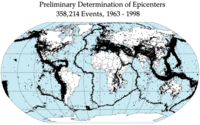
Photo from wikipedia
Surface ruptures from the 18 April 1906 M∼7.9 San Francisco earthquake were distributed over an ∼35-meter-wide zone at San Andreas Lake on the San Francisco Peninsula in California (Schussler, 1906).… Click to show full abstract
Surface ruptures from the 18 April 1906 M∼7.9 San Francisco earthquake were distributed over an ∼35-meter-wide zone at San Andreas Lake on the San Francisco Peninsula in California (Schussler, 1906). Since ∼1906, the surface ruptures have been largely covered by water, but with water levels at near-historic low levels in 2008–2011, we observed that the 1906 surface ruptures were no longer visible. As a fault imaging test, we acquired refraction tomography and guided-wave data across the 1906 surface ruptures in 2011. We found that individual fault traces, as mapped by Schussler (1906), can be identified on the basis of discrete low-velocity zones (VS and VP, reduced ∼40% and ∼34%, respectively) and high-amplitude guided waves. Guided waves have traditionally been observed as large-amplitude waveforms over wide (hundreds of meters to kilometers) zones of faulting, but we demonstrate that by evaluating guided waves (including Rayleigh/Love- and P/SV-types) in terms of peak ground velocity (PGV), individual near-surface fault traces within a fault zone can be precisely located, even more than 100 yr after the surface ruptures. Such precise exploration can be used to focus paleoseismic trenching efforts and to identify or exclude faulting at specific sites. We evaluated PGV of both S-wave-type and Fϕ-mode-type guided waves and found that both wave types can be used to identify subsurface fault traces. At San Andreas Lake (main fault), S-wave-type guided waves travel up to 18% slower than S body waves, and Fϕ-mode guided waves travel ∼60% slower than P body waves but ∼15% faster than S body waves. We found that guided-wave amplitudes vary with frequency but are up to five times higher than those of body waves, including the S wave. Our data are consistent with the concept that guided waves can be a strong-shaking hazard during large-magnitude earthquakes.
Journal Title: Bulletin of the Seismological Society of America
Year Published: 2020
Link to full text (if available)
Share on Social Media: Sign Up to like & get
recommendations!